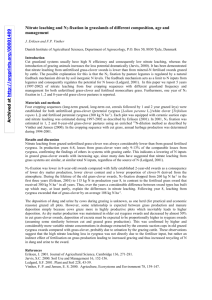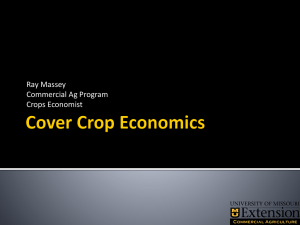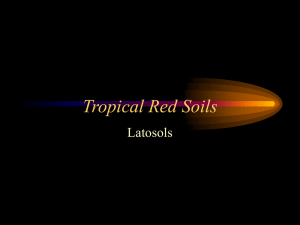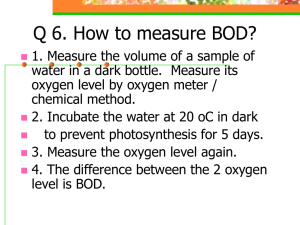INTRODUCTION
advertisement
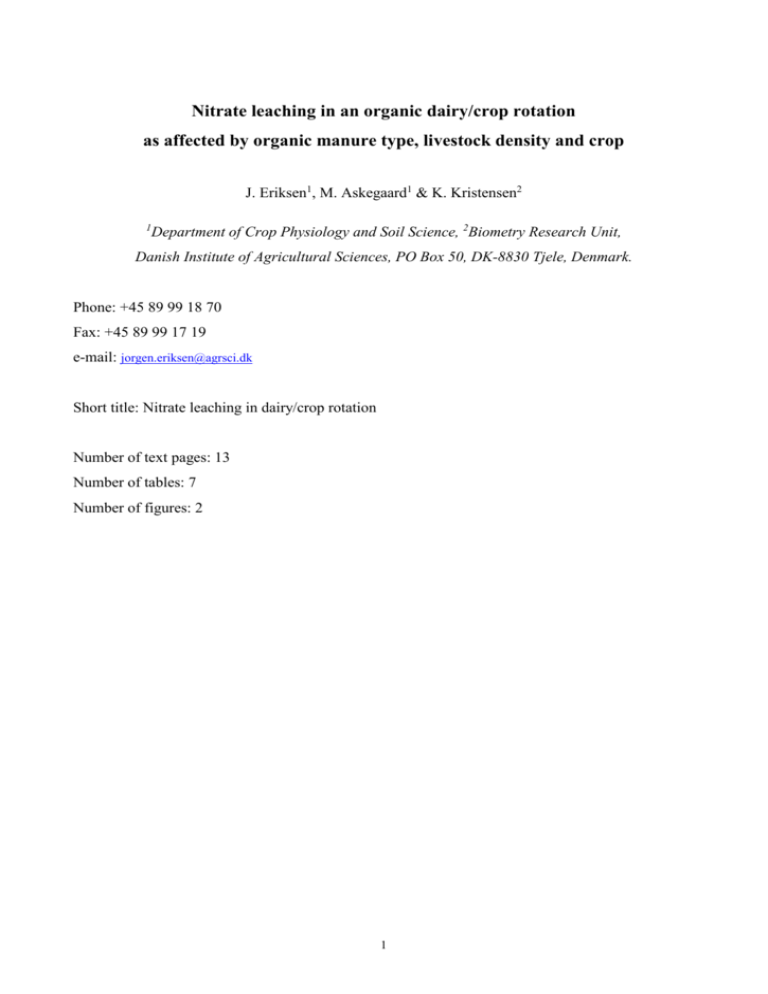
Nitrate leaching in an organic dairy/crop rotation as affected by organic manure type, livestock density and crop J. Eriksen1, M. Askegaard1 & K. Kristensen2 1 Department of Crop Physiology and Soil Science, 2Biometry Research Unit, Danish Institute of Agricultural Sciences, PO Box 50, DK-8830 Tjele, Denmark. Phone: +45 89 99 18 70 Fax: +45 89 99 17 19 e-mail: jorgen.eriksen@agrsci.dk Short title: Nitrate leaching in dairy/crop rotation Number of text pages: 13 Number of tables: 7 Number of figures: 2 1 Abstract. In dairy farming systems the risk of nitrate leaching is increased by mixed rotations (pasture/arable) and the use of organic manure. We investigated the effect of four organic farming systems with different livestock densities and different types of organic manure on crop yields, nitrate leaching and N balance in an organic dairy/crop rotation (barley – grass-clover – grass-clover – barley/pea – winter wheat – fodder beet) from 1994 until 1998. Nitrate concentrations in soil water extracted by ceramic suction cups ranged from below 1 mg NO3-N/l in 1st year grass-clover to 20-50 mg NO3-N/l in the winter following barley/pea and winter wheat. Peaks of high nitrate concentrations were observed in 2nd year grass-clover, probably due to urination by grazing cattle. Nitrate leaching was affected by climatic conditions (drainage volume), livestock density and time since ploughing in of grass-clover. No difference in nitrate leaching was observed between the use of slurry alone and farmyard manure from deep litter housing in combination with slurry. Increasing the total-N input to the rotation by 40 kg N/ha per year (from 0.9 to 1.4 livestock units/ha) only increased leaching by 6 kg NO3-N/ha. Nitrate leaching was highest in the second crop (winter wheat) following ploughing in of the grass-clover (61 kg NO3-N/ha). Leaching losses were lowest in 1st year grass-clover (20 kg NO3-N/ha). Averaged over the four, years nitrate concentration in drainage water was 57 mg/l. Minimising leaching losses requires improved utilisation of organic N accumulated in grazed grass-clover pastures. The N balance for the crop rotation as a whole indicated that accumulation of N in soil organic matter in the fields of these systems were small. Keywords: Nitrate, leaching, slurry, farmyard manure, nitrogen balance, crop rotation, organic farming 2 INTRODUCTION In Danish aquifers nitrate concentrations commonly exceed the EC Drinking Water Directive upper limit of 50 mg/l (Duus Børgesen et al., 1997). The source of nitrate leaching from agricultural land is excess fertilizer N or mineralisation of crop residues and soil organic matter. In order to achieve optimal yields and reduce the risk of nitrate leaching in arable crops it is important that N added to the soil in crop residues and animal manure is available at the time of plant growth. Preferably, Nmineralisation in the soil should be synchronised with the N-uptake by crops. The potential for nitrate leaching from rotations with organic manure is considered larger than from rotations with mineral fertilisers (e.g. Thomsen et al., 1993), although “good management practices” such as avoiding autumn N-application and over-fertilisation will reduce nitrate leaching (Beckwith et al., 1998). In dairy farming, the nitrate leaching potential is further increased by mixed rotations of pasture with arable crops, where symbiotic N2-fixation by clover can import large amounts of N. The residual effect of the pasture with clover is large, so in the first year following ploughing-in of the pasture, the need for N-fertilizer is small, but in the following years gradually more and more fertilizer N is required to achieve reasonable yields (Francis et al., 1995). Thus, the mixed rotation has three phases with different objectives for nutrient management: i) the pasture phase where N2-fixation is maximised to increase N-availability in the system, ii) the years immediately after ploughing-in of the pasture, when N-consumption by crops is optimised to maximise fodder production and to minimise nitrate leaching and iii) the later years where utilisation of N in manure are optimised for the same reasons. The objective of this work was to investigate the effect of four types of organic farming systems with different livestock densities and different types of organic manure (slurry and farmyard manure [FYM] from deep litter housing) on crop yields and nitrate leaching in a dairy crop rotation where “good management practices” with organic manure were implemented. A secondary objective was to draw up N-balances for the organic treatments to estimate long-term differences in nitrate leaching potential. MATERIALS AND METHODS 3 Site The dairy/crop rotation is located at the Research Centre Foulum, in the central part of Jutland, Denmark (9°34’E, 56°29’N). The soil is classified as a Typic Hapludult with 7.7% clay and 1.6% carbon. The fields were converted to organic farming in 1987, when a six-year rotation was introduced replacing a conventional cereal rotation (Table 1). Field experiment In autumn 1993 and spring 1994 four organic manure treatments with four replicates were established (Table 1), replacing the previous slurry application. The treatments represent two systems of cattle housing based on either slurry alone or a combination of slurry and deep litter at two livestock densities. The livestock densities were 0.9 and 1.4 livestock units (LU) per hectare. One LU is equivalent to 1 milking cow of a large breed. In the slurry system 1 LU corresponded to 114 kg total-N in manure, and in the combined system with FYM from deep litter housing and slurry 1 LU corresponded to 124 kg total-N in manure. The difference was caused by the straw-N content in FYM. To ensure realistic conditions detailed feed and fertiliser budgets were made for each system. The amount of organic manure for application was calculated as total production minus manure excreted during grazing. Organic manure was applied in spring on the basis of total-N content and incorporated into the soil immediately, or applied to growing plants using trail hose application. The difference between the 0.9 and 1.4 LU/ha systems was on average 40 kg of total-N (Table 2). In slurry, dry matter content was 6-8% and NH4-N was 50-60% of total-N. In FYM, dry matter content was 27-31% and NH4-N was 2-21% of total-N. Each of the six fields in the rotation was divided into four blocks, in which the treatments were randomly placed in plots of 15x18 m. From mid-June, the grass-clover fields were grazed by cattle following one cut of herbage. The treatments with 0.9 and 1.4 LU/ha were grazed by two separate groups of heifers (average weight 446 kg). On average the grass-clover fields were subject to 455 animal days/ha/y. After spring-ploughing of the 2nd year grass-clover, barley was sown in a mixture with pea and ryegrass which in Juli/August was harvested green for silage production. The stubble was ploughed in late September and winter wheat was sown. After harvest of winter wheat, the field was left undisturbed, except for 2-3 passes with a harrow for weed control, until the following spring when fodder beet was sown. The beets were harvested in October-November and the field 4 left undisturbed until spring when after ploughing barley was sown with a mixture of white clover and ryegrass to establish the following grass-clover. Occasionally irrigation was used especially to maintain the grass-clover fields in summer. Harvest yields were obtained from an area measuring between 36 and 108 m2 depending on the crop. A plot combine was used for cereals and grass-clover, whereas fodder beet was removed by hand. Subsamples were taken for determination of dry matter and N content. Nitrate leaching Before the experiment started, three ceramic suction cups were installed in each of the 96 plots at a depth of 1 m and 2 m apart. Every 1 or 2 weeks, depending on precipitation, a suction of approximately 80 kPa was applied 3 days prior to sampling. The samples were either analysed separately or bulked with equal sample volume from each of the three replicates per plot before analysis for nitrate concentrations by the method of Best (1975). The water balance was calculated using the model Evacrop (Olesen & Heidmann, 1990) for which inputs were daily meteorological measurements (precipitation, temperature and evaporation) and crop type, time of sowing, cutting and irrigation and soil physical parameters. Nitrate leaching was estimated using the trapezoidal rule (Lord & Shepherd, 1993), assuming that nitrate concentrations in the extracted soil water represented average flux concentrations. The accumulated leaching was calculated from 1 April to 31 March. In the four experimental years variations in climatic conditions resulted in differences in drainage of more than 500 mm (Table 3). Statistical analysis The amount of leached nitrate for all crops and years was analysed using the following general linear model (Searle et al., 1992): Yyctfb = y + c + t + ()yc + ()yt + ()ct + Cfb + Dyfb + Eyctfb where Yyctfb are the logarithm of the recorded nitrate leaching of treatment t in crop c in block b of field f in year y y, c and t are the main effect of year y, crop c and treatment t ()yc, ()yt and ()ct the interactions between year y, crop c and treatment t Cfb, Dyfb and Eyctfb are independent normally distributed random variables with zero mean and variances 2C, 2D and 2g, respectively. The ‘g’ denotes that the variance of Eyctfb depends on 5 whether the crop was a grass or a non-grass. The purpose of this was to take into account the larger variation of nitrate leaching from grass crops than from other crops. After an initial analysis for checking the assumptions, the non-significant term for interactions with treatments was removed from the model. In the analysis we ignored some conditions in the data, i.e. the same data for water balance were used for all plots of a given crop. The parameter estimates were used to compare treatment, crop, year and crop by year means on the log scale. These means were then back transformed to the original scale to form tables of means for treatment, crop, year and year by crop. In this back transformation the variance components were taken into account together with a specific empirical factor for each of the four tables to let the means of each table be identical to the overall mean of the raw data. The comparison test results were copied to the back transformed means. RESULTS AND DISCUSSION Nitrate concentrations Soil water extracted at 1 m depth using suction cups is believed to represent soil water percolating from the root zone in sandy soils (Barbee & Brown, 1986). Figure 1 illustrates the level of nitrate concentration in percolating water in the crop rotation from 1st of April 1994 to 31st of March 1998 as an average of the four replicates, which includes a total of 12 suction cups. The nitrate concentrations ranged from below 1 mg NO3-N/l in 1st year grass-clover to 20-50 mg NO3-N/l in the autumn and winter following the barley/pea wholecrop and winter wheat. In all crop sequences in Figure 1 the upper limit of the EC Drinking Water Directive (11.3 mg NO3-N/l) was exceeded at some stage during the four years. Nitrate concentrations were clearly affected by climatic conditions (Table 3). In the second experimental year (1995-96) when the drainage volume was extremely low, nitrate concentrations did not increase in autumn and winter as observed in the other three years. Because of a frozen soil, samples could not be taken from January to March 1996. The organic manure treatments did not show consistent differences in nitrate leaching except in barley/pea wholecrop in 1996-97. A spring application of 60 kg N/ha as slurry and 90 kg N/ha as FYM doubled the nitrate concentrations in the period from November 1996 to February 1997 6 compared with no manure application. These observations were probably caused by high initial levels of soil inorganic N in spring 1996, due to a low winter rainfall. Effect of cattle grazing Peaks of high nitrate concentrations were observed in 2nd year grass-clover every year. The peaks always occurred in only one of the four replicates and were not related to treatment differences. For instance, concentrations of 200 mg NO3-N/l were observed in one of the replicates for a short period, while at the same time concentrations in the remaining replicates were around 10 mg NO3N/l (Fig. 2). From November 1996 to March 1997 samples from each individual suction cup in the 2nd year grass-clover were analysed separately, showing that the peaks were from one suction cup of the 12 cups per treatment. Since the concentration increased and decreased gradually and the suction cup was working satisfactorily, the observation could not be regarded as an analytical error. And since the peaks always appeared shortly after a period of substantial drainage (Fig. 2) it seems likely that the observation was due to urination by the grazing cattle. Hack-ten Broeke et al. (1996) have shown that the random urination by cattle can lead to patches with deposition of between 400 and 1200 kg N/ha. It has been found that preferential flow of nitrate can take place in macropores formed by the burrowing activity of earthworms (Shipitalo et al., 1994). However, because of the gradual increase in concentration over several samplings (Fig. 2) it is unlikely that the peaks in this experiment were due to preferential flow. Nitrate leaching The quantity of nitrate leaching depends on soil nitrate concentrations, but also on the drainage volume, which was subject to considerable variation between years. The estimated accumulated nitrate leaching was large in 1994-95 because of high drainage volumes with only moderate nitrate concentrations. In the extremely dry winter of 1995-96 nitrate concentrations were almost similar to the previous year, but due to low drainage volumes the accumulated leaching was only a few kg/ha. Nitrate leaching from the four fertiliser treatments was significantly different (Table 4). Leaching losses were greater from the systems with 1.4 LU/ha than the system with only 0.9 LU/ha, whereas no differences were observed between the use of slurry alone and FYM from deep litter housing in combination with slurry. However, the differences in leaching between the two livestock densities were only 6 kg NO3-N/ha, which is of little agronomic or environmental significance. The 7 small effect of rate of manure application on nitrate leaching was probably due to the protective agronomic practices used, such as spring application of organic manure, and manure application below the N-optimum for the crop (Lord & Michell, 1998; Vinten et al., 1991). The results are comparable with those of Johnson et al. (1997), who found only limited effects of reducing the Napplication from full to half recommended rate in a five-course crop rotation system aimed at decreasing nitrate loss as much as possible. In contrast to the small differences between treatments, large differences in nitrate leaching were found for the different crops. As an average of the four experimental years, leaching was highest in the three crops following ploughing-in of the grass-clover (Table 5). In the winters following barley/pea, winter wheat and fodder beets nitrate leaching was 43, 61 and 48 kg N/ha, respectively. Leaching losses were lowest in 1st year grass-clover (20 kg NO3-N/ha). It has been demonstrated that early autumn ploughing of grass-clover increases leaching losses compared with delayed ploughing in winter or spring (Djurhuus & Olsen, 1997; Francis et al., 1992). Our results showed that even when the grass-clover sward was spring-ploughed, there was a high risk of nitrate leaching in the following years in a dairy/crop rotation. Increased nitrate leaching was found in the 2nd year grass-clover compared to 1st year grassclover, especially in the two years with the highest drainage. The explanation may be that the buildup of organic N in the grass-clover generally increased mineralisation, and at the same time animal grazing caused a high return of N in excreta. Especially when the excreta are deposited in the autumn it can cause considerable leaching losses (Cuttle & Scholefield, 1995). The leaching loss from the six-course dairy/crop rotation was 38 kg NO3-N/ha as an average of the four experimental years. This is equivalent to a nitrate concentration in drainage water of 57 mg/l, which is close to the guideline concentration of 50 mg NO3/l. However, further improvement of the crop rotation in order to minimise leaching losses is possible. The key to this is improved utilisation of organic N accumulated in grazed grass-clover fields. To minimise leaching losses it is important to take into account the effect of the grass-clover when fertilising the following crop and to establish efficient catch crops after ploughing of the grass sward (Francis, 1995). Nitrogen balance In order to estimate differences in accumulation of soil N and long-term leaching potential, nitrogen balances were made for the fields in the rotation. The input of N to the crop rotation consists of 8 organic manure-N, N in irrigation water, atmospheric deposition and N2-fixation by clover and peas. The first three can be determined with good analytical precision, whereas N2-fixation is extremely difficult to determine, especially under grazing conditions. The input in irrigation water was up to 17 kg N/ha (135 mm with 12.7 mg NO3-N/l) and the atmospheric deposition has previously been determined at 14 kg N/ha/y on this location (Grundahl & Hansen, 1990). The N2-fixation in the rotation was determined by Vinther & Jensen (1998) in ungrazed and unfertilised areas of the fields using an enriched 15 N-dilution method. Taking into account the reduction in N2-fixation caused by cattle-grazing (Eriksen & Høgh-Jensen, 1998; Vinther, 1998) the net fixation in 1st year grass-clover was estimated at 185 kg N/ha and in the 2nd year grass-clover at 254 kg N/ha. Including N2-fixation in peas and all grass-clover fields, the N-input to the rotation as a whole was 85, 91 and 69 kg N/ha in the years 1994-96. Major outputs from the crop rotation were N in plant material (Table 6) and nitrate leaching. The weight gain of grazing cattle was also considered an output. Assuming 2.61% N in cattle (Sibbesen, 1990) up to 13 kg N/ha was exported from the grass-clover fields in meat. The Nconcentration in plant material was in general only slightly affected by the different treatments (Table 6). As a consequence of yield increases, N-concentrations in barley straw and the barley/pea wholecrop decreased with increasing fertilizer application. Increasing the livestock density from 0.9 to 1.4 LU/ha increased yields of barley and wheat grain, of the barley/pea wholecrop and of wheat straw (Table 6). In contrast, no significant yield differences were observed between slurry application alone and a combination of slurry and FYM application. N balances for all experimentally determined inputs and outputs in the crop rotation (organic manure, irrigation, seeds, plant material, weight gain of cattle, and leaching losses), are in Table 7. Not included in the balances are atmospheric deposition and N2-fixation which, on average, was estimated at a total of 96 kg N/ha/y. When these additional inputs are included, the surplus of the balance for the crop rotation of the four systems ranged from 28 to 70 kg N/ha per year. However, gaseous losses of N must also be considered. Under similar conditions Jarvis et al. (1989) estimated the ammonia emission from grazed pasture to constitute 3 and 11% of N in faeces and urine excreted, respectively. In the present study these figures correspond to ammonia emissions of 8-18 kg N/ha per year, depending on the development of herbage quality during the grazing period. Denitrification losses, including N2O emissions, have been estimated at 8-13 kg N/ha per year (Colbourn, 1993; Klein & van Logtestijn, 1994; Ledgard et al., 1996; Ruz-Jerez et al., 1994). Thus, 9 total gaseous losses from the grazed pastures are expected to be in the order of 16-31 kg N/ha per year. Furthermore, slurry application will have resulted in gaseous loss when applied to pasture (Whitehead, 1995). It follows that the surplus of the balance is considerably reduced when considering these gaseous losses. Also, it is likely that differences between treatments will be further reduced since the gaseous losses at animal manure application (Sommer & Olesen, 1991), as well as N-losses during grazing (Petersen et al., 1998) are related to the N-application rate and N-intake, respectively. Thus, assuming that the estimates of N2-fixation and gaseous N-losses are the right order of magnitude, the accumulation of N in soil organic matter (the surplus of the balance) in the fields of these systems is likely to be small. However, our present knowledge of temporal variations in N2-fixation and gaseous losses in grazed systems is too limited to draw any firm conclusions on N-accumulation in these systems. CONCLUSIONS In the present experiment nitrate leaching losses were not related to the type of organic fertiliser (cattle slurry alone or cattle FYM in combination with slurry) and only slightly related to the livestock density of the farm. The assumptions for this to be true in any farming system is that good farming practices regarding organic fertiliser management and fertilisation rates not exceeding the N-optimum of the crop are adhered to. Leaching losses of nitrate were related to the ploughing-in of the grass-clover pasture and the largest leaching losses were observed in the three years following the ploughing. Also, significant leaching losses were observed in the 2nd year of the pasture partly caused by animal excreta judging from the random nature of these observations. ACKNOWLEDGEMENT Financial support was provided by the Ministry of Food, Agriculture and Fisheries in the research programme “Organic Farming 1993-97”. The technical assistance of Holger Bak and the staff at 10 Foulumgaard is gratefully acknowledged. We also thank Søren O. Petersen for his calculations and advice on estimates of gaseous emissions. REFERENCES BARBEE, G.C. & BROWN, K.W. 1986. Comparison between suction and free-drainage soil solution samplers. Soil Science 141, 149-154. BECKWITH, C.P., COOPER, J., SMITH, K.A. & SHEPHERD, M.A. 1998: Nitrate leaching loss following application of organic manures to sandy soils in arable cropping. I. Effects of application time, manure type, overwinter crop cover and nitrification inhibition. Soil Use Management 14, 123130. BEST, E.K. 1975. An automated method for determining nitrate-nitrogen in soil extracts. Queensland department of primary industries. Bulletin no. 739. COLBOURN, P. 1993. Limits to denitrification in two pasture soils in a temperate maritime climate. Agriculture, Ecosystems and Environment 43, 49-68. CUTTLE, S.P. & SCHOLEFIELD, D. 1995. Management options to limit nitrate leaching from grassland. Journal of Contaminant Hydrology 20, 299-312. DJURHUUS, J. & OLSEN, P. 1997. Nitrate leaching after cut grass/clover leys as affected by time of ploughing. Soil Use Management 13, 61-67. DUUS BØRGESEN, C., KYLLINGSBÆK, A. & DJURHUUS, J. 1997. Model simulations of nitrogen leaching from Danish agriculture (in Danish with English abstract). SP-report no. 19. The Danish Institute of Agricultural Sciences, Tjele. ERIKSEN, J. & HØGH-JENSEN, H. 1998. Variations in the natural abundance of 15N in ryegrass/white clover shoot material as influenced by cattle grazing. Plant and Soil 205, 67-76. FRANCIS, G.S. 1995. Management practices for minimising nitrate leaching after ploughing temporary leguminous pastures in Canterbury, New Zealand. Journal of Contaminant Hydrology 20, 313-327. FRANCIS, G.S., HAYNES, R.J., SPARLING, G.P., ROSS, D.J. & WILLIAMS, P.H. 1992. Nitrogen mineralization, nitrate leaching and crop growth following cultivation of a temporary leguminous pasture in autumn and winter. Fertilizer Research 33, 59-70. 11 FRANCIS, G.S., HAYNES, R.J. & WILLIAMS, P.H. 1995. Effects of the timing of ploughing-in temporary leguminous pasture and two winter cover crops on nitrogen mineralization, nitrate leaching and spring wheat growth. Journal of Agricultural Sciences, Cambridge 124, 1-9. GRUNDAHL, L. & HANSEN, J.G. 1990. Atmospheric deposition of nutrients in Denmark (In Danish). Npo-report no. A6. Ministry of the Environment, Copenhagen. HACK-TEN BROEKE, M.J.D., DE GROOT, W.J.M. & DIJKSTRA, J.P. 1996: Impact of excreted nitrogen by grazing cattle on nitrate leaching. Soil Use Management 12, 190-198. JARVIS, S.C., HATCH, D.J. & LOCKYER, D.R. 1989: Ammonia fluxes from grazed grassland: annual losses from cattle production systems and their relation to nitrogen inputs. Journal of Agricultural Science, Cambridge 113, 99-108. JOHNSON, P.A., SHEPHARD, M.A. & SMITH, P.N. 1997. The effect of crop husbandry and nitrogen leaching from a shallow limestone soil growing a five course combinable crop rotation. Soil Use Management 13, 17-23. KLEIN, C.A.M. DE & LOGTESTIJN, R.S.P. VAN 1994: Denitrification and N2O emission from urine- affected grassland soil. Plant and Soil 163, 235-241. LEDGARD, S.F., SPROSEN, M.S., BRIER, G.J., NEMAIA, E.K.K. & CLARK, D.A. 1996: Nitrogen inputs and losses from New Zealand dairy farmlets, as affected by nitrogen fertilizer application: year one. Plant and Soil 181, 65-96. LORD, E.I. & MITCHELL, R.D.J. 1998 Effect of nitrogen inputs to cereals on nitrate leaching from sandy soils. Soil Use Management 14, 78-83. LORD, E.I. & SHEPHERD, M.A. 1993. Developments in use of porous ceramic cups for measuring nitrate leaching. Journal of Soil Science 44, 435-449. OLESEN, J.E. & HEIDMANN, T. 1990. EVACROP. A program for calculating actual evaporation and drainage from the root zone. Version 1.01. Research note no. 9, Dept. of Agrometeorology, Danish Institute of Agricultural Sciences, Tjele. PETERSEN, S.O., SOMMER, S.G., AAES, O. & SØEGAARD, K. 1998. Ammonia losses from urine and dung of grazing cattle: effect of N intake. Atmospheric Environment 32, 295-300. RUZ-JEREZ, B.E., WHITE, R.E. & BALLS, P.R. 1994. Long-term measurements of denitrification in three contrasting pastures grazed by sheep. Soil Biology Biochemistry 26, 29-39. 12 SEARLE, S.R., CASELLA ,G. & MCCULLOCH, C.E. 1992. Variance Components. John Wiley & Sons, Inc. New York SHIPITOLA, M.J., EDWARDS, W.M. & REDMOND, C.E. 1994. Comparison of water movement and quality in earthworm burrows and pan lysimeters. Journal of Environmental Quality 23, 13451351. SIBBESEN, E. 1990. Nitrogen, phosphorous, and potassium in fodder, animal produce and animal manure in Danish agriculture in the 1980ies. Report no. S2054. Danish Institute of Plant and Soil Science, Tjele. SOMMER, S.G. & OLESEN, J.E. 1991. Effects of dry matter content and temperature on ammonia loss from surface-applied cattle slurry. Journal of Environmental Quality 20, 679-683. THOMSEN, I.K., HANSEN, J.F., KJELLERUP, V. & CHRISTENSEN, B.T. 1993. Effects of cropping system and rates of nitrogen in animal slurry and mineral fertilizer on nitrate leaching from a sandy loam. Soil Use Management 9, 53-58. VINTEN, A.J.A., HOWARD, R.S. & REDMAN, M.H. 1991. Measurement of nitrate leaching losses from arable plots under different nitrogen input regimes. Soil Use Management 7, 3-14. VINTHER, F.P. 1998. Biological nitrogen fixation in grass-clover affected by animal excreta. Plant and Soil 203, 207-215. VINTHER, F.P. & JENSEN, E.S. 1998. Estimating legume N2 fixation in grass-clover mixtures of a grazed organic cropping system using two 15N methods. Submitted to Agriculture, Ecosystems and Environment. WHITEHEAD, D.C. 1995. Grassland nitrogen. CAB International, UK. 13

